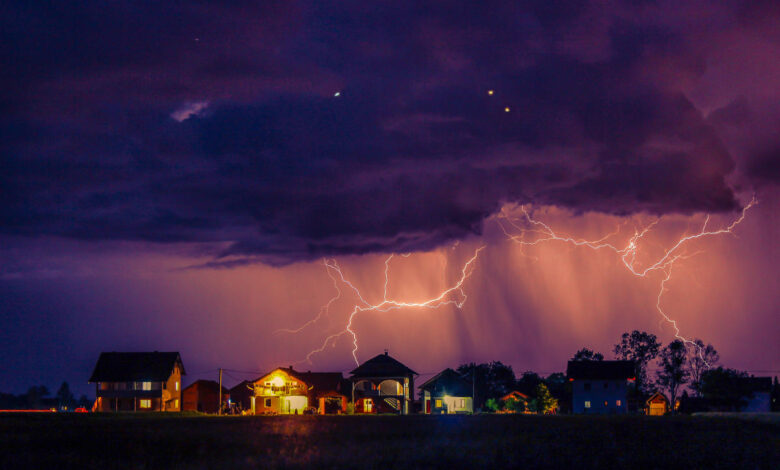How to stay safe during heavy rain, lightning and tornadoes

Storms sweeping across the central U.S. beginning on April 15 could inundate as many as 40 million Americans with large hail, high-speed winds and even tornadoes, meteorologists warned Monday. Weather — from heat to cold to tornadoes and rip currents — was responsible for 869 deaths and 1,200 injuries in 2022, according to the most recent data from the National Weather Service (NWS). Heat is responsible for the highest number of fatalities, but flooding killed more than 90 Americans and lightning, tornadoes and high winds during thunderstorms claimed 74 lives that year. And extreme weather is becoming only more common due to climate change, according to the Environmental Protection Agency (EPA).
As we enter the spring storm season, here’s what you need to know to keep yourself and your family safe.
What are the biggest risks thunderstorms pose?
Lightning may be the flashiest feature of thunderstorms, but it’s flooding that’s the most fatal. Flooding is responsible for more than 75 fatalities a year in the U.S. on average, according to the Federal Emergency Management Agency (FEMA). “People don’t realize just how fast floodwaters can rise, once urban or even suburban sewage wastewater management systems have been overwhelmed,” Dr. Cecilia Sorensen, a professor of environmental health sciences and emergency medicine at Columbia University, tells Yahoo Life. “You can see a foot of standing water accumulating in under 30 minutes on a roadway; it’s really scary how quickly those floodwaters can rise.”
If there is a flood warning or heavy rainfall in your area, do not get your car, Sorensen warns, adding: “That’s the No. 1 thing.” Cars can easily be swept away by flash flooding. “If you find yourself on a roadway that’s actively flooding, get to higher ground as soon as possible,” Sorensen says. She also suggests keeping an emergency kit, containing things such as nonperishable food, a flashlight, warm clothing, water and your essential medications in your car, in case you’re ever caught in a storm and can’t get home or need to wait out flooding on higher ground.
The National Severe Storms Laboratory says that other places that are particularly dangerous during floods include:
-
Densely populated areas with lots of concrete and less soil to absorb rainwater
-
Areas near rivers, streams and creeks
-
Regions around dams and levies
-
Low areas like basements, underground parking garages, underpasses and low water crossings
Lightning: The odds of getting struck — and how to make sure you don’t
There’s about a 1-in-15,300 chance that a person will be struck by lightning in an 80-year lifespan, according to the NWS. That’s pretty rare, but a risk worth taking seriously nonetheless, Sorensen says. Lightning is responsible for an average of 33 deaths and 182 injuries a year, according to FEMA, although that rate fell to 27 between 2009 and 2018, according to the NWS, which says that only about 10% of people struck by lightning die. However, the other 90% are left with “various degrees of disability,” the agency notes.
Most lightning strike fatalities are instant because the powerful jolt short-circuits the biological system that controls the heartbeat, causing immediate cardiac arrest. Survivors are often left with neurological damage, not unlike that seen in football players who are concussed over and over again, or nerve pain, as well as mental health conditions such as PTSD and depression.
To stay safe when thunder rumbles and lightning streaks the sky, first and foremost: Go inside, urges FEMA. You’re far less likely to be struck by lightning when you’re inside. But it’s still possible. That’s why it’s important to avoid touching anything that can conduct electricity if lightning does strike the structure. That includes plugged-in electronics (everything from a charging cellphone to a blender), wires, metal plumbing, doors or windows, and water. In fact, you should never shower if there’s a thunderstorm in the area. “Lightning currents could, for example, get inside the house through the electrical wiring, spark to the pipes and give you a shock while in the shower or the tub,” Joseph Dwyer, a professor of physics and astronomy at the University of New Hampshire, tells Yahoo Life.
If you’re in the car, roll up all your windows and don’t touch any plugged-in electronics, the ignition or any metal surfaces that lead to the car’s exterior through which lightning could travel if it strikes the vehicle, the NWS advises.
How to stay safe during tornadoes
Second only to hurricanes, tornadoes are among nature’s most destructive forces with wind speeds ranging from 65 mph to over 200 mph, according to the NWS. An average of 71 people are killed by tornadoes each year, the agency reports. But as the Earth becomes warmer and wetter, extreme events like tornadoes may be getting more intense, more common and more deadly. “We get storming in ocean waters throughout the seasons, but the chances of those ending up on land is going up, and a lot of that is due to climate change,” Sorensen says. “The ocean is warming and reaching unprecedented temperatures and we also have warmer air temperatures and all that means more energy, and that energy is what fuels these storms.”
In 2022, there were 23 U.S. tornado deaths. In 2023, there were 83 fatalities, even though only an average number of tornadoes formed. Scientists think that 2023’s tornadoes were particularly deadly in part because they occurred at night, making them less visible and more dangerous.
While it’s best to get to high ground to avoid flooding, the Centers for Disease Control and Prevention (CDC) says to do the opposite during tornado warnings and watches: Get as low as you can. That means going into a basement or storm shelter if you have one at home or nearby, or getting on the floor of the most interior, windowless part of your house — such as a hallway, bathroom or closet — if you don’t have a basement. The majority of injuries and fatalities from tornadoes are not due to people being lifted from the ground, but from flying debris and glass, the NWS says. So avoid windows and exterior rooms, if you can. You can add a layer of protection by getting under a very heavy table, or covering yourself with a blanket, sleeping bag or mattress to shield your body from sharp shards of glass, metal or other broken objects, the CDC says.
How to be prepared for storm season
If there are storms in your area, watches and warnings will be issued by the NWS and local meteorologists. “Take guidance from local authorities seriously and do not wait until the last minute” to evacuate or shelter in place, Sorensen says. Tune into your local meteorologists online or on the TV or radio to be sure you are aware of any warnings, she says, and follow their instructions without hesitation.
Now that spring is here, it’s a good idea to make sure you and your family have your communication, evacuation and shelter-in-place plans set. “Think about your communications plan with loved ones because there’s a risk of getting separated,” she says. Know where and how you can quickly get to high ground if your area is struck by flooding.
It’s equally important to be prepared to get stuck at home, possibly without power. “What would you do if you lost electricity for five days?” asks Sorensen. She advises stocking enough water, nonperishable foods and essential medications to last two weeks. You should also be sure you have flashlights and plenty of spare batteries, a first aid kit, sleeping bags or blankets in case it gets cold and tools like manual can openers that don’t rely on electricity for basic functions, like opening food containers, she says.
Also, don’t shy away from talking to your kids about your plan and how they can help the family prepare. “Talk them through it and get them involved,” Sorensen says. “Doing something proactive about it is a great way to ameliorate their stress and anxiety.”




